Barbara de Vries’s “Living Upriver: Artful Homes, Idyllic Lives”
By Jane Anderson | Photos by Barbara de Vries | Winter 2023 | Design Feature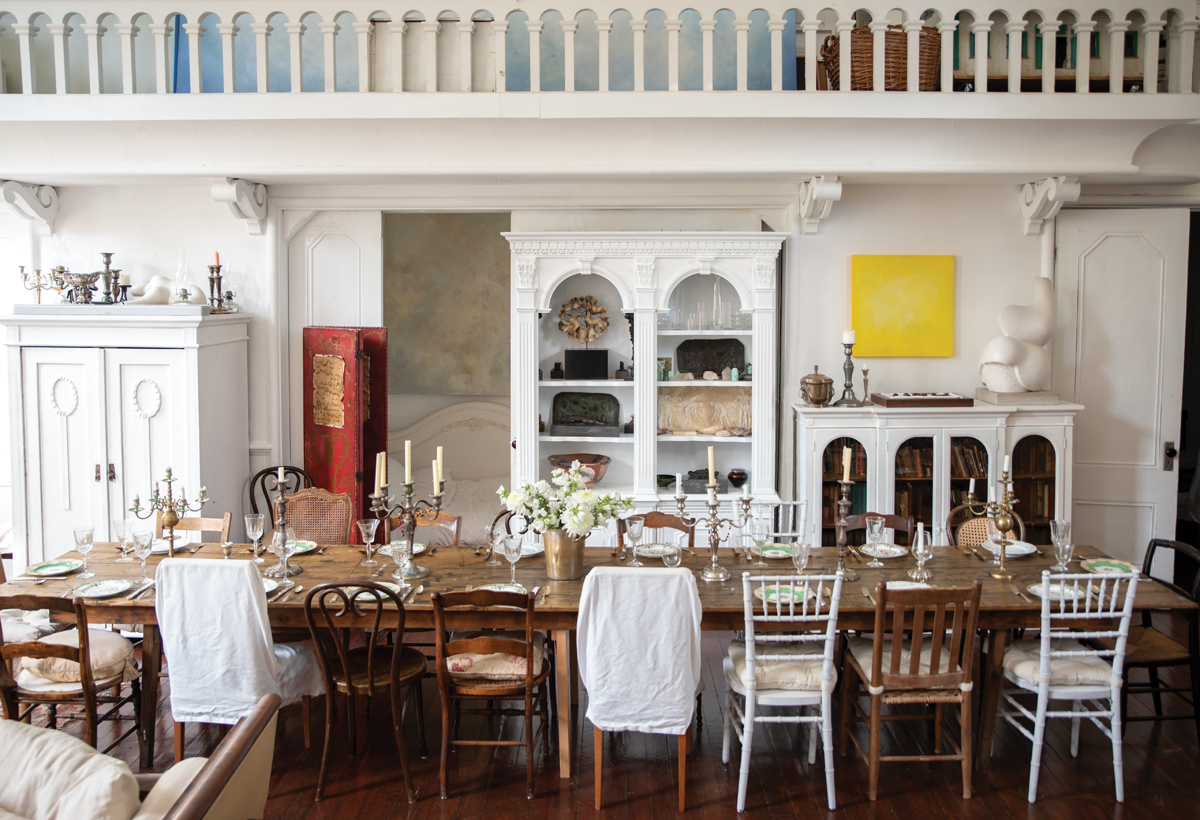
The concept of “home” comprises many perspectives: the hygge of a warm fire and cozy blanket, golden sunlight slanting onto a well-worn floor, and comfort shared at the table around a home-cooked meal. Writer/photographer Barbara deVries explores the homes and livelihoods of creatives spanning the Hudson and Delaware valleys in her latest book, Living Upriver: Artful Homes, Idyllic Lives, published this fall by Rizzoli.
“Researching and doing the work on this book was incredibly satisfying and cozy in itself,” de Vries says. The book richly displays exteriors and interiors of a baker’s dozen of houses up and down the Hudson and Delaware. Living Upriver goes further than just stunning photography; de Vries recounts the “origin story” of the homeowners—how they discovered the area, why they chose or built their houses, and the ways they’ve made them their homes.
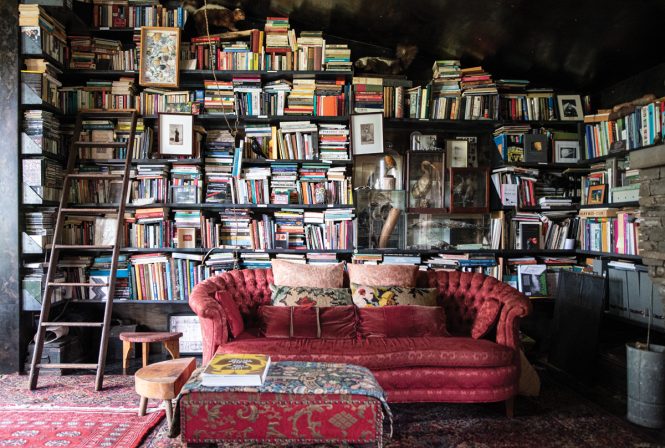
The library at Mildred’s Lane, a creative community and gathering space by J. Morgan Puett in Pennsylvania near Narrowsburg along the Delaware River.
“The story idea was born during Covid,” de Vries says. She and her husband, writer/critic Alastair Gordon, hunkered down in their mountaintop home in Milford, Pennsylvania, with their daughters—Iona and twins Kiki and Leila. “Our twins were in school still,” de Vries continues. “They’d all be working in their respective spaces throughout the house, and in the evening, we would come together and cook. I truly appreciated that sense of home.”
de Vries fought off pandemic-borne isolation by scrolling social media. “I was on Instagram a lot at the time—it seemed to be a way to find out how the rest of the world was doing.” She started noticing that creatives, from artists and writers to photographers and actors, were using their houses as a way to display their creativity and design. That sparked an idea for de Vries: to connect all those people in the upper Hudson River and Delaware River into one narrative.
Focusing on a 2.5-mile radius from their Milford home, de Vries scouted more than two dozen houses, including those with which she was most familiar: the homes of friends.
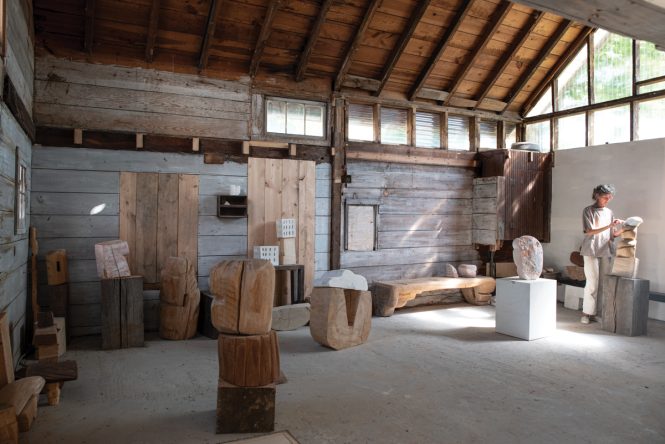
J. Morgan Puett’s “Mildred’s Lane”—a 96-acre farmstead on the Upper Delaware—nearly defies description, yet de Vries does a bang-up job of doing just that. “We’d been going to Mildred’s Lane for 20 years,” de Vries says, of Puett’s “experimental community” of meals and salons. “It was our Saturday night hangout during Covid.” That familiarity shines through in de Vries’s photographs of not only the interiors and exteriors of the slatted hemlock house, but portraits of the people there and the artworks within. Capturing the moodiness of the space, Living Upriver celebrates the simplicity of textiles drying on a clothesline and tables set for a dozen.
O Pioneers!
de Vries honors “pioneer” East Village expats painter Julie Hedrick and musician Peter Wetzler, who moved to Kingston in the ‘80s, as well as relative newcomers who fled upriver during Covid. Page by page, the book uncovers de Vries’s curated interpretations of the beauty of home.
Readers discover that there’s no one definition of “upriver” living; each home has its own story, its own feel, its own character. “I was impressed by everyone; they’re all visionaries,” de Vries explains. “They don’t see what it looks like at the time, but what it would look like in the future.” And that future is fluid, as the story of Todd Carr and Carter Harrington’s Greene County farmhouse shows. A mixed retail/art/botanical space, Hort and Pott (short for horticulture and pottery) overflows with verdant vines from floor to ceiling. de Vries’s images capture the horticulture in striking relief against the dark interiors of the home, bringing to mind the still lifes of the Old Masters. She recalled in the interview that she was thoroughly enthralled with the space, which was at first difficult to define. “It’s interesting that they’ve created an enigma,” de Vries says. “As a visitor, rather than entering with an idea for what you want, you’re the one who’s challenged—because they know exactly what they’re doing.”
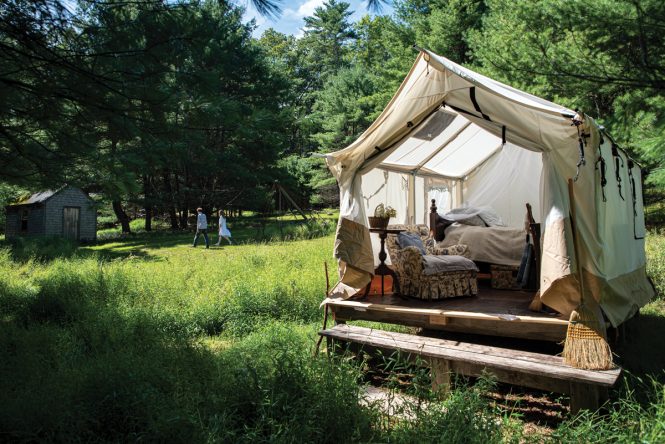
J. Morgan Puett and her then-partner Mark Dion, along with artist friends Renee Green and Nils Norman bought a 96-acre farmstead on the banks of the Delaware River in 1997 to form the creative community Mildred’s Lane, where artfully furnished tents like this one (that still exists on the property) pre-dated “glamping.”
Living Upriver also gives readers a glance into the lives of more well-known upstaters, like Laura Chavez Silverman of the Outside Institute and its Outpost in Callicoon. Again, de Vries forgoes the traditional exterior, living room, kitchen, bedroom photos in favor of following Silverman on one of her nature walks; zooming in on a Monarch butterfly and explaining how to help the endangered insect; and showcasing the contentment of a cat snuggled up on a duvet.
Nothing looks staged, because nothing is staged. “In photographing the homes, I only used ambient light, because I really enjoy it,” de Vries says. Her lifelong experience in design—first as a model, with a Cosmopolitan cover on her resume, then a fashion designer who helped launch Calvin Klein’s CK in New York—sculpted her eye behind the camera, too. She tried to take as many shots as she could on one visit, and only returned to a few homes for more nuanced additions: “It’s kind of like an embroidery: You go back and add the final touches.”
The love that de Vries has for her subjects comes through in her images. A two-page spread of Nadia Yaron’s sunlit studio has the sculptor off to the side; she is spotlit in sunlight, and her sculptures are front and center. A pine-sided farmhouse in Bovina is a handsome structure in itself; through de Vries’s text, readers discover that the house’s design incorporates elements from a historic Massachusetts tavern and a home from the owners’ college travels in the Czech Republic. Such fascinating facts elevate the images.
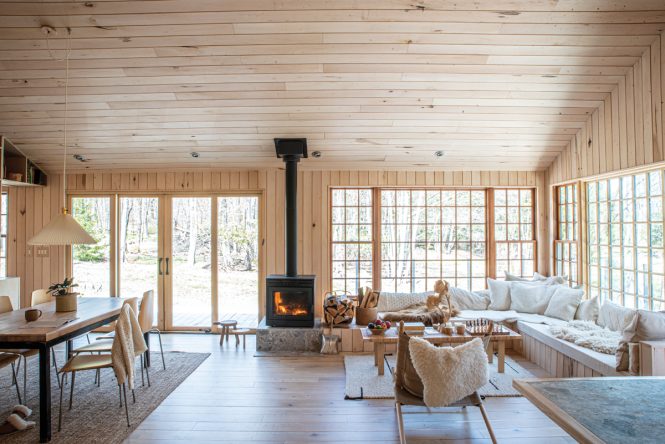
de Vries actually wrote the text for the book on another river, in another country altogether. When shooting finished, de Vries’s mother fell ill, so the author flew to her Netherlands homeland to help care for her. “I wrote the text along the Zaan River, upriver from Amsterdam; it’s a very beautiful place,” de Vries explains. “I had a lot of quiet time in which to write.” Her family is imprinted throughout the book, with some shots taken by her husband, and the creative, woodsy title font created from scratch by one of her daughters.
The book is a celebration of homes that are well loved and well lived-in, with a thread of creativity that, like the rivers emulated in the title, runs seamlessly through it.
